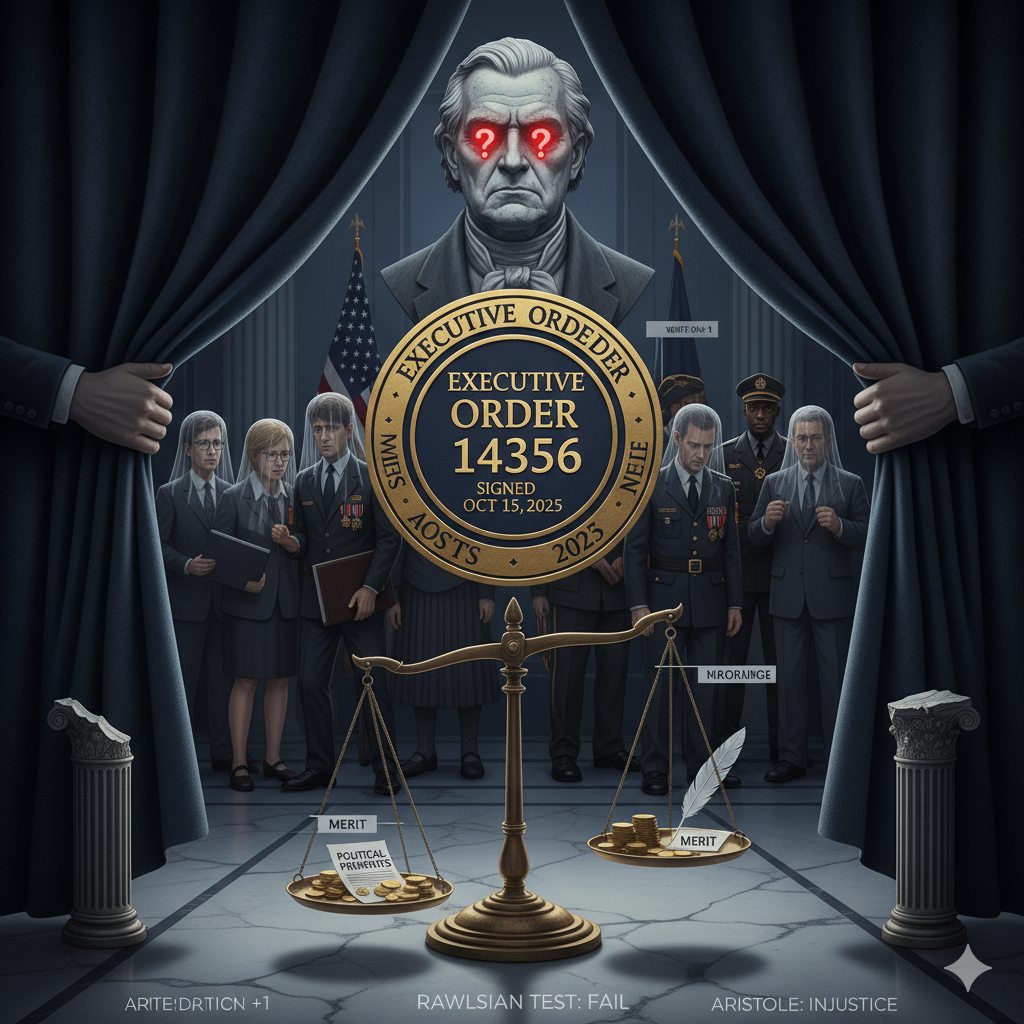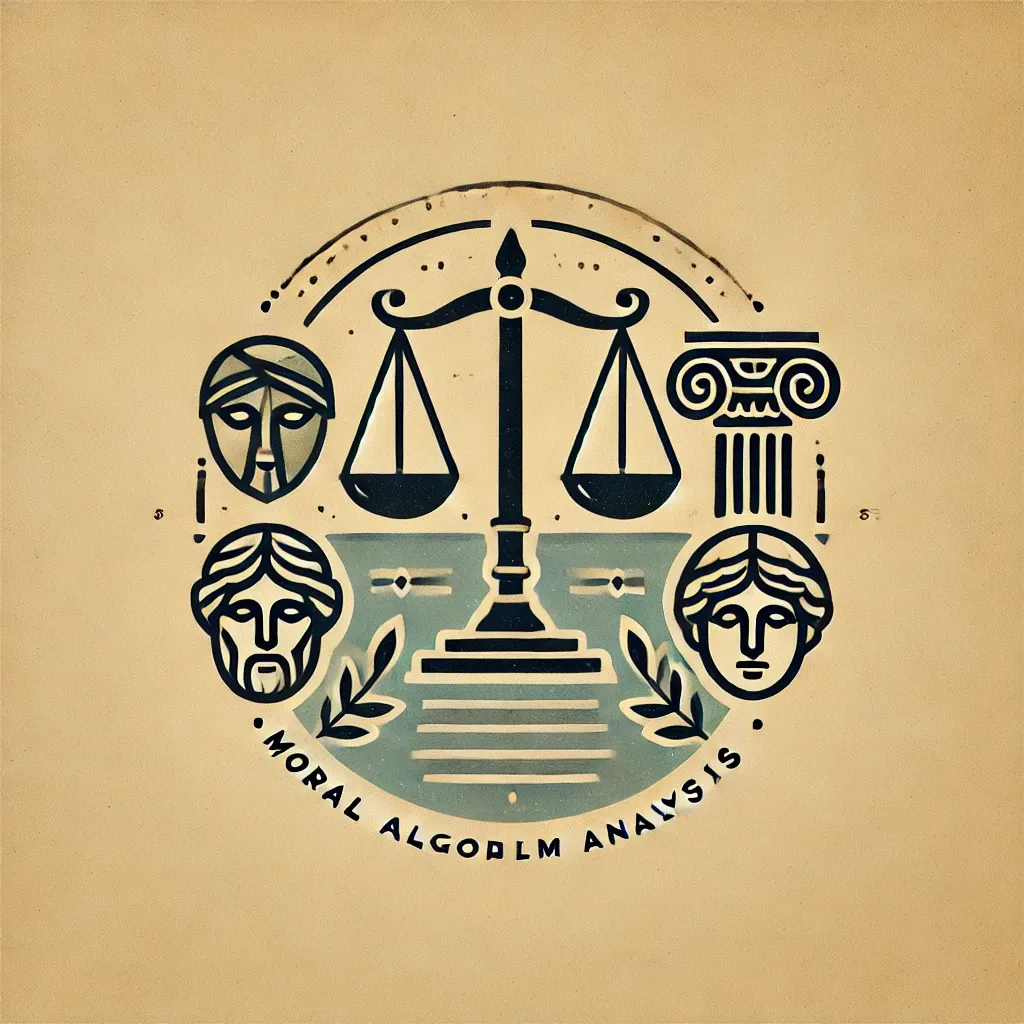Accountability or Autocracy? The Moral Indictment of Executive Order 14356
An ethical analysis of Executive Order 14356. Does the new federal hiring policy meet the standards of Adams, Rawls, and Aristotle, or does it risk politicizing the civil service?

Today we examine Executive Order 14356, titled Ensuring Continued Accountability in Federal Hiring, signed October 15, 2025. On its face, this policy seeks to bring discipline to the hiring practices of our federal bureaucracy — to restrain unchecked growth, ensure alignment with national priorities, and reinforce oversight over vacancy creation and job filling. Agencies must now establish Strategic Hiring Committees, submit detailed staffing plans, and see every new position or hire vetted under the lens of the President’s declared priorities. White House+1
Yet beneath the surface lies a troubling ethical landscape. Under the moral algorithm of John Adams, while advancing the “common good” is professed, the exercise of power here leans more toward institutional control than safeguarding citizen welfare and fairness. There is no robust mechanism here to redress past injustices in hiring; rather, the ordering of hiring becomes centrally politicized, offering fertile ground for private or partisan interest. The result: a failure to meet Adams’ test.
Under John Rawls’ original‑position thought experiment, the veil of ignorance would reveal substantial risks: If you were an applicant, a career civil servant, a minority candidate, or someone seeking new employment, would you operate under confidence of fairness and consistency in a system where each new hire depends on alignment with political priorities and a freeze of positions? Most likely not. The policy fails the Rawlsian litmus test of fairness and equality of opportunity.
From the vantage of Aristotle’s virtue ethics the decision strikes as lacking in key aspects of justice and human flourishing. While oversight implies prudence, the broad hiring freeze and recommendation to align with a President’s priorities rather than merit or institutional need undercut fairness, and risk reducing flourishing for both employees and the public they serve.
Therefore the conclusion is unequivocal: this order does not satisfy our three ethical frameworks. It concentrates control, introduces avenues for politicization of government employment, and potentially undermines merit, fairness, and individual flourishing. As a policy, it may indeed achieve the stated objective of accountability, but at the expense of key moral premises we hold dear in democratic governance.
In closing, I strongly advise that any implementation of this order include robust safeguards: transparent criteria for what constitutes “agency need” and “national interest,” independent oversight to protect merit‑based hiring, protections for minority and veteran applicants, and periodic review of its impact on service delivery and employee equity. Without these, the risk is that accountability becomes a veneer for consolidation of power — a shift away from the ethos of public service and toward politicized personnel control.
Below is a structured ethical‑analysis report of this executive order, using the frameworks you requested:
Key Actors
- The President (in this case, Donald J. Trump) — issue‑setter.
- Federal agencies (Executive Branch departments) required to comply with the order and implement its mandates.
- Agency senior officials (e.g., agency heads, deputy heads, chief of staff) who will sit on “Strategic Hiring Committees”. Government Executive+2Akin - Akin, an Elite Global Law Firm+2
- The broader federal workforce and potential job applicants — whose hiring prospects, job security and career paths are affected.
- The public / taxpayers — as stakeholders in how the federal workforce is shaped.
Core Decisions
- The executive order continues or extends a hiring freeze on federal civilian positions, except for certain roles tied to public safety, national security, immigration enforcement. Government Executive+1
- It mandates that agencies establish Strategic Hiring Committees within 30 days, and submit an “Annual Staffing Plan” within 60 days, and regular updates to the Office of Personnel Management (OPM) and the Office of Management and Budget (OMB). Akin - Akin, an Elite Global Law Firm+1
- It requires that any creation of new positions or filling of vacancies must be aligned with “agency needs, the national interest, and the priorities of my Administration” (i.e., the President’s priorities) as overseen by the Strategic Hiring Committee. White House+1
- In effect, it centralizes oversight of federal hiring decisions and reduces automatic hiring/filling of vacancies without strategic review.
Justifications Provided
- The order is justified on the grounds of ensuring accountability, aligning hiring with the “common good” (as the administration defines it) rather than expanding the federal workforce arbitrarily. White House+1
- It argues that existing hiring practices may have allowed redundant or unneeded positions, or misalignment with policy priorities of the Administration.
- The order purposely continues a hiring freeze as a cost‑control and restructuring measure (reduce size of federal workforce). Government Executive
Issues Identified
- Risk that the hiring freeze plus centralized committee oversight could undermine merit-based selection and independence of non‑political career civil servants.
- By requiring alignment with agency head and Presidential priorities, there is a possibility of politicization of hiring, favouring ideological loyalty rather than competence.
- The broad freeze may hinder agencies’ ability to fulfil mission critical functions, especially non‑public‑safety roles, and may degrade service delivery.
- The “strategic” nature of hiring aligned with Presidential priorities may reduce transparency about how “agency need” and “national interest” are defined and applied.
- Potential impact on diversity, equity in hiring: even though not explicitly about DEI, the consolidation and freeze may disproportionately affect minority recruitment or upward mobility.
- Legal and ethical questions about whether such an order undermines the role of career civil service protections, and whether adequate safeguards for fairness have been included.
Ethical Analysis
1. John Adams’ Moral Algorithm
- Does the decision serve the common good? The stated goal is to ensure federal hiring is more aligned with national interest and reduce excessive growth of government. If executed well, that could align with the public interest. However, the risk is that it serves institutional interests (downsizing, political control) more than public welfare.
- Does it avoid private interest or special‑interest capture? The order centralizes oversight and could reduce certain arbitrary hiring, but it also increases power of political appointees and may favour particular networks or agendas (private political interest).
- Does it reform injustice? There is no explicit attempt in the order to remedy past injustices in federal hiring (e.g., discrimination, nepotism), rather it institutes a hiring freeze and oversight mechanism. So it is weak on reforming injustice.
Verdict: The order partially aligns with Adams’ criterion of common good in its stated goals, but fails in avoiding institutional/private interest capture and lacks a focus on reforming injustice. Thus: Fail in Adams’ framework.
2. John Rawls’ Veil of Ignorance
If a rational person behind a veil of ignorance (not knowing whether they will be a new hire, a career civil servant, minority applicant, or agency head) were designing this system:
- Would they consent to a hiring regime that restricts filling vacancies indefinitely and hands broad review power to political committees? Possibly not, since they might fear being disadvantaged, delayed, or subjected to political criteria rather than purely merit.
- Would they accept that all agency hiring must align with the President’s priorities and national interest, without guaranteed processes for fairness and transparency? Likely not.
- Would they want safeguards that protect fairness, stable career paths, independent civil service protections? The order seems to weaken these.
Verdict: The system fails the Veil of Ignorance test: it places uncertainty, potential disadvantage and political risk on individuals behind the veil. Fail.
3. Aristotle’s Virtue Ethics
- Does the decision promote justice? It aims to stop unaccountable hiring, but may itself introduce injustice (favoritism, politicization, undermining stable civil service) if not balanced with safeguards.
- Does it demonstrate virtue (prudence, moderation, fairness)? Centralizing hiring committees may demonstrate prudence in oversight, but may lack moderation if hiring freeze is unchecked; fairness is at risk.
- Does it promote eudaimonia or flourishing of humans? For individuals seeking federal jobs, the freeze and increased political oversight may reduce their opportunity for flourishing. For the public, if service quality suffers, public flourishing may be reduced.
Verdict: This order struggles to meet virtue ethics criteria: while there is an intent of prudent governance, the fairness and flourishing components are weak. Fail.
Summary Chart
| Framework | Pass/Fail |
|---|---|
| John Adams’ Moral Algorithm | Fail |
| John Rawls’ Veil of Ignorance | Fail |
| Aristotle’s Virtue Ethics | Fail |
Additional Considerations
- Political economy: The hiring freeze is part of a broader agenda to shrink the federal workforce and shift functions or resources to the private sector. This can have significant downstream implications for service delivery, employee morale and institutional capacity.
- Equity and civil service: The order may exacerbate inequality in hiring if minority or lower‑tier applicants face longer delays or fewer opportunities due to freeze and political oversight.
- Transparency and accountability: While oversight is increased, the criteria for “agency need” and “national interest” may be vague, making decisions less transparent and possibly arbitrary.
- Implementation risk: Agencies may experience understaffing, morale problems, attrition, or inability to recruit talent if they cannot fill vacancies reasonably. This may undermine mission success.
